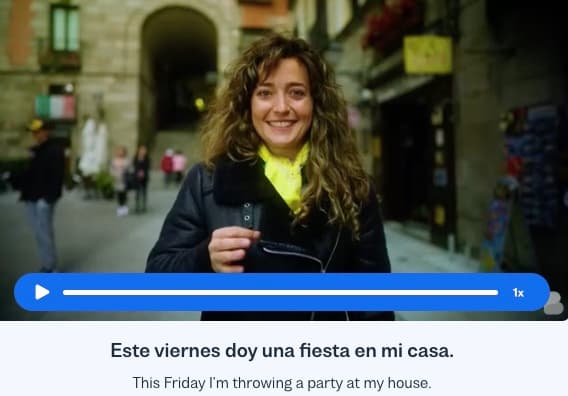I want to learn...
If you’re ready to learn possessive adjectives in Spanish, it means you’ve progressed from learning nouns, verbs, and basic sentence structure. Congratulations!
Starting with a new language can be daunting, but now you've overcome the initial challenges, setting a strong foundation for further language learning success.. At Busuu, we are excited to help you continue on your Spanish-language learning journey.
In this post, we will explore possessive adjectives in Spanish and when, how, and why you use them. Today, we aim to improve your understanding and ability to describe the relationship between two objects.
What are Spanish possessive adjectives?
Let’s get started! Understanding the fundamental role of possessive adjectives will help you know how to use them in Spanish.
Like in English, possessive adjectives are used to help you indicate to what or to whom an object or person is related.
It's important to note that possessive adjectives in Spanish agree with the gender and number of the noun they modify, not with the person possessing the noun. This means that the possessive adjective matches the noun's gender (masculine or feminine) and number (singular or plural).
For example:
"Mi casa" (My house) - Here, "mi" agrees with the feminine singular noun "casa".
"Nuestros libros" (Our books) - "Nuestros" agrees with the masculine plural noun "libros".
To further understand possessive adjectives in Spanish, it is necessary to know that there are determinantes átonos (unstressed possessive adjectives) and determinantes tónicos (stressed possessive adjectives), respectively:
Unstressed possessive adjectives
Unstressed possessive adjectives are the most common and standard forms used in everyday speech and writing.
They are used before the noun they modify.
They are more neutral and do not emphasize possession.
Table of unstressed possessive adjectives in Spanish
| Person | Masculine Singular/Plural | Feminine Singular/Plural | Masculine Singular/Plural | Feminine Singular/Plural |
|---|---|---|---|---|
| 1st Person | mi/mis | mi/mis | nuestro/nuestros | nuestra/nuestras |
| 2nd Person | tu/tus | tu/tus | vuestro/vuestros | vuestra/vuestras |
| 3rd Person | su/sus | su/sus | su/sus | su/sus |
Note: The word tu is not the same as the word tú when there is an accent over the “u”. When we use tu, it is to indicate to whom or what someone or something is connected to. (Tu hermano tiene cinco amigos.) Tú is a personal pronoun used in reference to a specific person. (Tú tienes un hermano.)
Stressed possessive adjectives
Stressed possessive adjectives are words that highlight the focus of the noun to the adjective itself.
This form of an adjective is used less commonly and is always placed after the noun they describe.
When using stressed possessive adjectives in a sentence, the person or thing being possessed is less important than the person or thing possessing it.
Table of stressed possessive adjectives in Spanish
| Person/Number | Masculine Singular/Plural | Feminine Singular/Plural | Masculine Singular/Plural | Feminine Singular/Plural |
|---|---|---|---|---|
| 1st Person | mío/míos | mía/mías | nuestro/nuestros | nuestra/nuestras |
| 2nd Person | tuyo/tuyos | tuya/tuyas | vuestro/vuestros | vuestra/vuestras |
| 3rd Person | suyo/suyos | suya/suyas | suyo/suyos | suya/suyas |
How to use Spanish possessive adjectives
Remember that possessive adjectives agree in gender, person, and number with the nouns they modify. Nevertheless, they also change depending on singular/plural possession; i.e, how many people own one or multiple things.
1. Unstressed possessive adjectives
Singular possession:
Mi hermano es alto. (My brother is tall.) - "Mi" agrees with the masculine singular noun "hermano."
Su casa es bonita. (His/Her/Your/Their house is beautiful.) - "Su" agrees with the feminine singular noun "casa."
Plural possession:
Nuestra fiesta será en el parque. (Our party will be in the park.) - "Nuestra" agrees with the feminine singular noun "fiesta." Vuestros amigos son simpáticos. (Your -plural- friends are friendly.) - "Vuestros" agrees with the masculine plural noun "amigos."
2. Stressed possessive adjectives
Singular possession:
Esta es mi bicicleta, y aquella es la tuya. (This is my bike, and that one is yours.) - "Mi" and "tuya" agree with the feminine singular noun "bicicleta."
Los libros son míos, no son suyos. (The books are mine, they are not hers/his) - "Míos" and "suyos" agree with the masculine plural noun "libros."
Plural possession:
Estos libros son vuestros. (These books are yours.) - “Vuestros” agrees with the masculine plural noun "libros." Note that the books are owned by multiple people.
Esta tienda es nuestra. (This shop is ours.) - “Nuestra” agrees with the feminine singular noun “tienda”. Note that the shop is not owned by multiple people.
Other ways to indicate possession
Possessive adjectives are not the only way to indicate possession when you speak Spanish. However, it is essential to know how to use possessive adjectives when speaking with a fellow Spanish speaker, as they are commonly used. Other grammatical forms of showing possession are when you use the word de.
When you use de, think of it as the equivalent of using the apostrophe “s” in English.
Possession usingde:
That is Oliver 's sweater. - Ese es el jersey de Oliver.
Tere’s umbrella is wet. - El paraguas de Tere está mojado.
Is that José’s car? - ¿Ese es el coche de José?
Is that Nora 's aunt? - ¿Es esa la tía de Nora?
This helps you to understand the different ways of expressing possession in Spanish. Dedicating the amount of time it takes to learn Spanish will help you learn and master the differences and to use them appropriately.
Keep up with possessive adjectives
You’re well on your way to mastering the use of possessive adjectives in Spanish!
When you are learning any new language, art, or skill, the key to getting better is always practice. Reviewing what we have covered in this article, continuing with lessons on Busuu, and speaking with someone who is fluent will help you to become familiar with Spanish grammar.
More importantly, it will get you to a point where you are comfortable speaking the language without having to think too hard about how to say something.
Newlanguages


